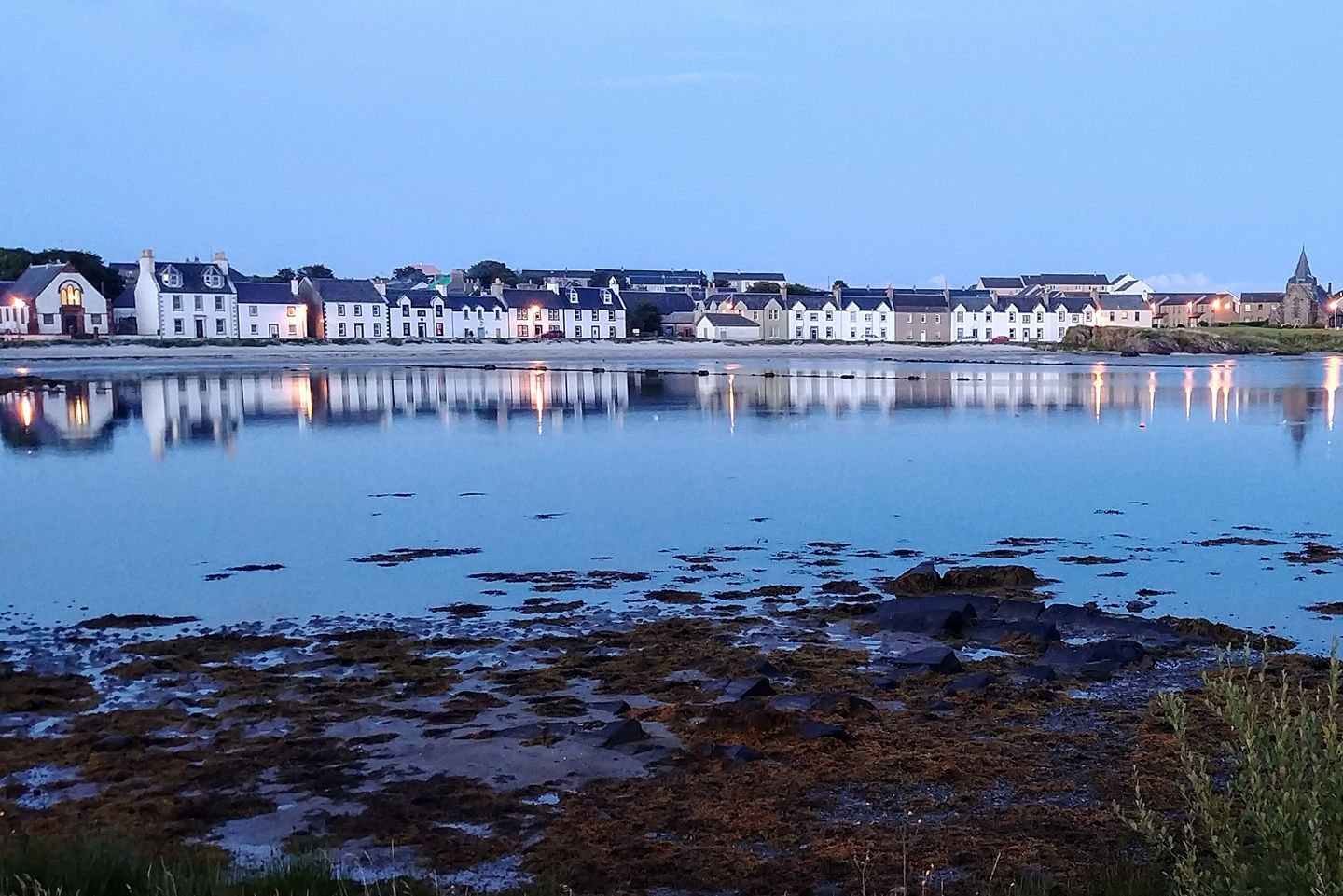When we started planning this trip in May, it didn't occur to us that we would spend half a day at the Ileach equivalent of a county fair, complete with purple sheep:

The day started here, however:

We took part in the warehouse tasting, in which Lagavulin's Iain Macarthur let us taste some malts pulled right out of the barrels, including a 35-year-old and a 23-year-old, worth well over £150 each.
Now we're chilling before catching live music at the only venue that's open anywhere near us tonight, the Islay Hotel.
Today, after a 6 km walk through squelchy bogs from Ardbeg up to Solam, and a drive to Bowmore, we had dinner in Port Ellen just before sunset. This was the scene after dinner:

I've got 759 photos to get through when we get back to the US in a couple of days. Meanwhile, my phone camera seems to be doing an adequate job, as the shot above shows. I think my SLR will yield better results overall, but for holiday snaps, the phone doesn't suck. I like living in the future.
I'm on a train hurtling through the English countryside at 200 km/h and using WiFi.
Seriously, why can't we have a train like this back home? I mean, some Amtrak routes have WiFi, and Acela maxes out at 240 km/h between Boston and New Haven, Conn. But that's it. Chicago to Milwaukee trains plod along at half that speed, and the trains to St. Louis are even slower (and frequently delayed by freight traffic).
Where's the President's infrastructure investment plan that we've heard so much about?
Via Eclipse2017.org, Xavier Jubier has created an interactive map showing all the data for the eclipse that takes place three weeks from today.
I'll be staying here the night before, and I'm planning to watch from here the day of.
Crossrail, the UK's £14.8bn rail line connecting London's far western suburbs with its eastern ones, either represents the end of an era or the beginning of one, according to today's New York Times:
Before Britain voted last summer to leave the European Union, Crossrail was conceived for a London open to the world and speeding into the future. Now, with Brexit, the nightmare scenario is that this massive project, to provide more trains moving more people more quickly through a growing city, ends up moving fewer people more quickly through a shrinking city.
Extending roughly 110 km, it is built to speed about 200 million passengers a year in a kind of Y from far to the west of the city, in the county of Berkshire, through Heathrow, to the heart of London, forking east to Shenfield in Essex and to the neighborhood called Abbey Wood, on the historically neglected southeast side of the Thames River. Linked with the existing Underground subway network, it will be rechristened the Elizabeth Line, inserting what is in effect a new steel-and-wheels spine into Britain’s capital.
“The danger with Brexit,” [George Iacobescu, Canary Wharf’s longtime chairman said], “is that if Britain gets out of the European Union and doesn’t keep the U.K. an attractive place for financial institutions, they will think twice about growing here. The issue isn’t banks leaving Canary Wharf. Most of them have long-term leases. The issue will be the pace of growth.”
But that’s not quite true. Because of Brexit worries, construction plans for several of Canary Wharf’s new buildings have already been put on hold. And long-term leases can always be broken.
The subway will open to passengers in 2018.
Scottish authorities are making it difficult for Donald Trump to expand his money-losing golf course outside Aberdeen:
Two Scottish government agencies—the Scottish Environment Protection Agency and Scottish Natural Heritage, a conservation agency—say they will object to the Trump Organization’s plans to build a second 18-hole golf course at Aberdeen, known as the Trump International Golf Links. If they succeed in killing this expansion, it will be a major setback for Trump and raise doubts about the future profitability of the whole venture.
Industry experts say the value of many of Trump’s golf resorts is not in the daily management of the course itself but rather in the development and sale of housing. And according to the 2008 master plan that Trump convinced local planning officials to accept, he needs to build two courses before he is allowed to break ground on the profitable housing development.
But with the Trump Organization back to trying to get the second golf course built, Scottish regulators are making the case that Trump apparently doesn’t fully understand the development limitations. According to the Guardian, the Scottish Environmental Protection Agency is objecting to the Aberdeen expansion on the grounds that the Trump Organization’s plans for managing sewage are inadequate. Scottish Natural Heritage, meanwhile, says the company’s expansion plans don’t take into account the fragility of the nearby dunes and how they may affect the course as they shift—already a recurring problem on the first course, where greens are strafed by mini-sandstorms.
It turns out, Scots are really hard to bully, and (as the headline above says), they really do not like him.
Usually when I work from home, I get a lot done. Today...not as much. I've run errands, had two meetings outside the house, and (to Parker's horror) vacuumed.
Now I'm off to another meeting, with half the house un-vacuumed and many emails unread.
Articles also unread:
Now, time for a board meeting.
...is now available. Don't worry, you haven't missed anything.
The 30-Park Geas (only 5 to go!) may be in hiatus this year, but for next year, the Post has a guide to all of them:
The experience at Wrigley begins far before you set foot inside, maybe the moment you order your first Old Style at Murphy’s or attack a gargantuan sandwich at Lucky’s. The ivy on the brick outfield walls remains one of the most identifiable, and gorgeous, features in baseball. Recent updates made it more comfortable and modern, without robbing Wrigley of its inherent charm. It’s cramped in the concourse, but you’ll be having too much fun to care.
Player insight: “I like the classic [ballparks] the best. … It’s nice sometimes to sit around in the dugout or the bullpen and look around and think of the history of it.” — Nationals relief pitcher Shawn Kelley
The Experts Rankings: 5th
Since they put AT&T Park, PNC Park, Camden Yards, and Fenway ahead of Wrigley, I might have to agree with the experts here.
A 5,800 km² iceberg broke free of the Larsen C ice shelf in Antarctica yesterday. That's not a good thing:
“It is a really major event in terms of the size of the ice tablet that we’ve got now drifting away,” said Anna Hogg, an expert in satellite observations of glaciers from the University of Leeds.
At 5,800 sq km the new iceberg, expected to be dubbed A68, is half as big as the record-holding iceberg B-15 which split off from the Ross ice shelf in the year 2000, but it is nonetheless believed to be among the 10 largest icebergs ever recorded.
But while the birth of the huge iceberg might look dramatic, experts say it will not itself result in sea level rises. “It’s like your ice cube in your gin and tonic – it is already floating and if it melts it doesn’t change the volume of water in the glass by very much at all,” said Hogg.
Now at the mercy of the ocean currents, the newly calved iceberg could last for decades, depending on whether it enters warmer waters or bumps into other icebergs or ice shelves.
The Larsen C calving yesterday wasn't necessarily caused by global warming, but it didn't help. Now we just wait and see if the entire Larsen C shelf goes into the ocean in the next few years. Meanwhile, be careful boating off Patagonia for the next few years.